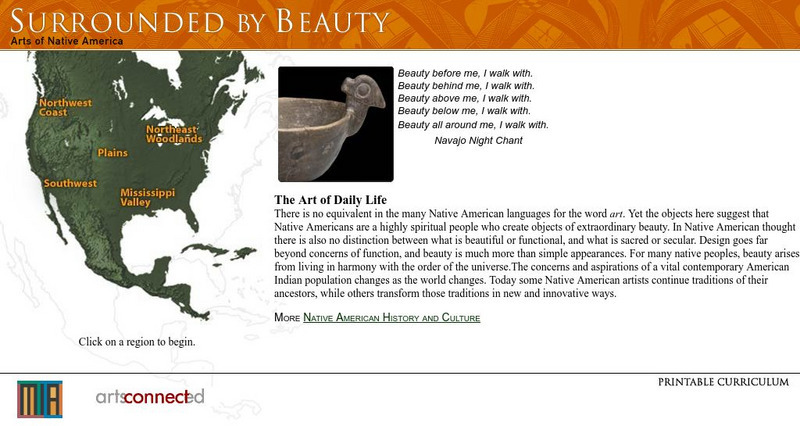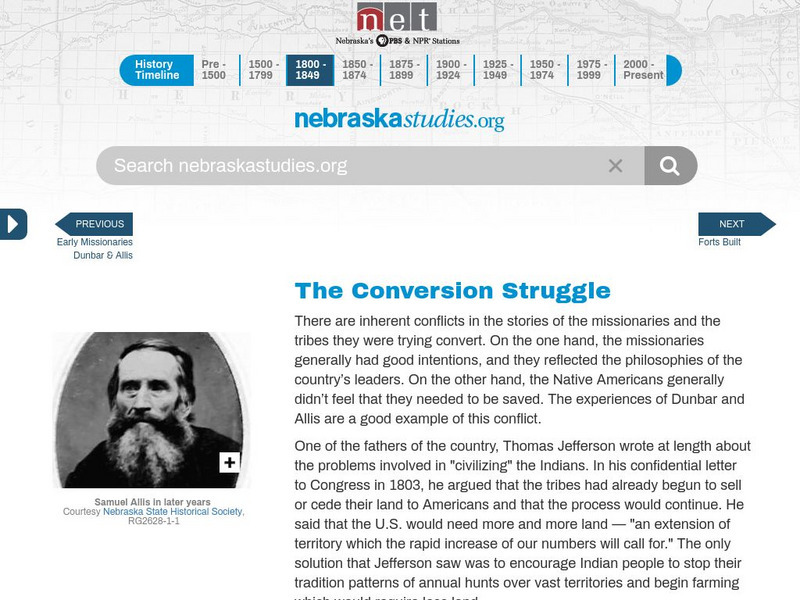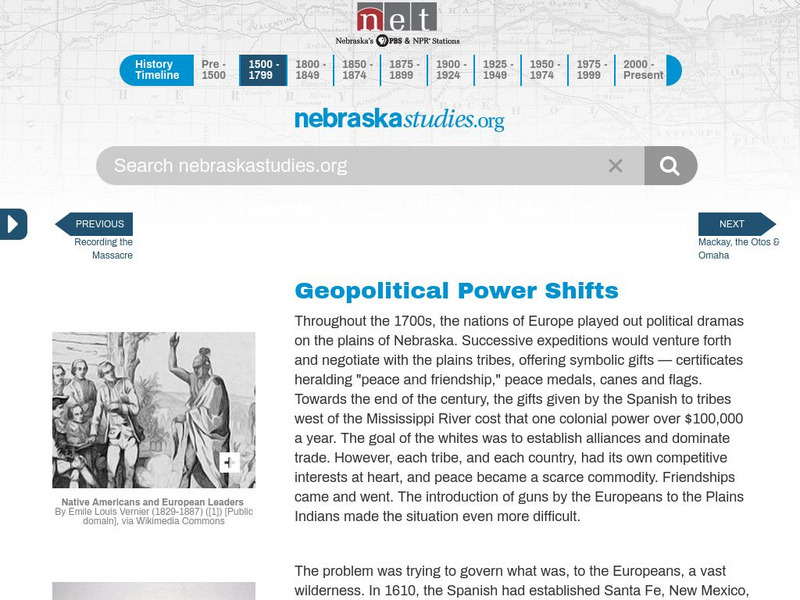Nebraska Studies
Nebraska Studies
A large site that tracks the history of the Nebraska area begins with the formation of the earth, moves through the earliest human activity in Nebraska, and then through proto-historical and historical Nebraska. The Kansas-Nebraska Act,...
Minneapolis Institute of Arts
Minneapolis Institute of Arts: Surrounded by Beauty: Arts of Native America
Explore the art, culture, and history of Native Americans through this Minneapolis Institute of Arts site. You'll find pieces of art from the Northeast Woodlands, Mississippi Valley, Plains, Southwest, and the Northwest coast, as well as...
Curated OER
National Park Service: Lewis and Clark Expedition: American Indians
Read about the various Native American tribes encountered by the Lewis and Clark Expedition.
Other
Calgary Board Education: Our First Nations: Blackfoot
Educators will find this a useful research model for their students. Each slide addresses a different aspect of the Blackfoot tribe's daily life and culture.
Ibis Communications
Eye Witness to History: Buffalo Hunt, 1846
Before the European settlers almost wiped out the buffalo, there were huge herds roaming the Plains.The buffalo hunts by Native Americans were essential for the survival of the tribes, and were fine tuned challenges between man and...
Other
Canku Ota: Regalia: Headwear: Part One
Describes the types of headwear worn by Native American tribes of the Northeast, Southeast, and the Plains.
Nebraska Studies
Nebraska Studies: The Conversion Struggle
The story of the problems on converting native Americans to a Christian religion. It uses the example of Christian missionaries who were trying to convert the Pawnee tribe in the 1830s.
Nebraska Studies
Nebraska Studies: Geopolitical Powershifts in Affect Life in Nebraska
As European colonists began settling in the Plains conflicts rose and ultimately led to the French and Indian War. These conflicts are outlined here.
National Humanities Center
National Humanities Center: Teacher Serve: Buffalo Tales: The Near Extermination of the American Bison
This National Humanities Center site offers an article which examines the main techniques on how the Plains Indian tribes hunted the buffalo.
Smithsonian Institution
National Museum of American History: Tracking the Buffalo
This explores the role of the buffalo in the lives of the American Indians of the northern plains.
University of Calgary
Native Civilizations
Blackfoot, Cree and Sioux cultures inhabited the plains. They were nomadic people who followed the roaming buffalo herds, hunting as needed to supply the essentials of life.
PBS
Frontier House: The Extermination of the American Buffalo
The reign of the buffalo across the plains ended in great slaughter by the end of the 19th century. This companion essay to the PBS series, Frontier House, recounts how the decimation of the buffalo occurred, hastened by both white and...
Other
Victoriana Magazine: Native American Tribes and u.s Government
The U.S. government's policies towards Native Americans in the second half of the nineteenth century were influenced by the desire to expand westward into territories occupied by these Native American tribes. By the 1850s nearly all...
Ducksters
Ducksters: Native American History for Kids: Sioux Nation and Tribe
Kids learn about Native American Indian tribe the Sioux Nation from the Great Plains of the United States on this site. Explore where the Sioux live, eat, and more on this website.
Legends of America
Legends of America: Arapaho Great Buffalo Hunters of the Plains
A very good overview of Arapaho history. It explains how the Arapaho split into the Northern and Southern Arapaho tribes and their relationships with the Cheyenne and the Sioux.
Annenberg Foundation
Annenberg Learner: United States History Map: Indians
An interactive site showing the Native American culture areas and the major tribes living in those areas before the arrival of the Europeans. Click to find out more about Indians living in those area and find a game that challenges you...
Curated OER
Perry Castaneda Map Collection: Map of Early Indian Tribes in the Western u.s.
Map showing the Native American culture areas and the tribes within those cultures in western North America. From the Perry Castaneda collection.
Library of Congress
Loc: Teachers: Journeys West
A series of lessons utilizing primary texts, including narratives, photographs, and maps, through which young scholars explore the following question: "What motivated thousands of people to journey west during the 1800s?"
Curated OER
All About Shoes Teacher Resources
The history and culture of the Plains Indians can be interpreted through footwear. Images of original specimens, teacher guides and worksheets provide an enhanced learning opportunity for students. There are two activities for ages 10-12...
Curated OER
All About Shoes Teacher Resources
The history and culture of the Plains Indians can be interpreted through footwear. Images of original specimens, teacher guides and worksheets provide an enhanced learning opportunity for students. There are two activities for ages 10-12...
Curated OER
All About Shoes Teacher Resources
The history and culture of the Plains Indians can be interpreted through footwear. Images of original specimens, teacher guides and worksheets provide an enhanced learning opportunity for students. There are two activities for ages 10-12...
Other
Pre Contact Culture Areas (Map)
This excellent map shows where different tribes were before first contact, links to related information.
Crayola
Crayola: Hides That Reveal (Lesson Plan)
A fun lesson plan for a class studying Native American culture. Young scholars create their own tepees, or animal hides with designs and symbols representing their own personality. Also contains adaptations and resources. (To access this...
Smithsonian Institution
Smithsonian: National Museum of the American Indian: Battle of Little Bighorn
The Battle of Little Bighorn made an immense impression on American society and culture. Americans became obsessed with this battle and created artworks, shows, postcards, and dime novels. View primary sources from this era to understand...


















